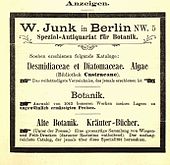Wilhelm Junk
Wilhelm Junk (own Wilhelm Jeitteles , officially approved change of name 1890; * February 3, 1866 in Prague , † December 3, 1942 in The Hague ) was a Berlin antiquarian , publisher , entomologist and bibliographer of natural history works.
Life
Wilhelm Junk was the son of Joseph Jeitteles, who holds a doctorate in chemical pharmacy, and his wife Caroline, née. Sobotka, who came from a large industrial family in Prague. After high school, Wilhelm Junk completed an apprenticeship as a bookseller in Berlin with his uncle Julius Friedländer in 1882 and attended university lectures in zoology , botany and the history of science during his training . In 1891 he became a partner and in 1899 he set up his own company "Verlag und Antiquariat für Naturwissenschaften W. Junk" in Berlin. Wilhelm Junk shared his interest in insects with Ernst Jünger and, as his antiquarian, supplied him with rare insect science works.
Junk married Elli Silbermann (1875–1942) and the couple had two children. In 1934 he emigrated to the Netherlands with his family and company. In 1935 he sold his second-hand bookshop, which still exists today under the name “Antiquariaat Junk” in Amsterdam, but kept his publishing house. After Junk's violent death in 1942, his son-in-law Walter Weisbach took over the management of the publishing house, which after his death in 1962 passed to his widow Irma-Marie Weisbach-Junk. Under the company name “Dr. W. Junk Publications ”, the publishing house with the focus on the edition of scientific works existed in The Hague until the 1980s.
Act
As an antiquarian, Wilhelm Junks was primarily interested in rare natural history works, especially botany and entomology. As a publisher, he published panels and catalogs on these areas. From 1901 to 1935, his publisher published new prints of rare old writings on natural history, including, for example, the Hispanic travel description de anno 1671 by Friederich Martens in 1925 .
In addition to the publication of contemporary scientific works, Wilhelm Junk devoted himself particularly to bibliographical work. Between 1909 and 1916 his “Bibliographia Botanica” was created in two volumes, in 1913 the “Bibliographia Lepidopterologica” and 1918 the “Vertebratorum Bibliographia”. Between 1912 and 1935 he worked out his "Bibliographia Coleopterologica". He published the bibliographic journal "Rara Historico-Naturalia et Mathematica" (1900-1939, appeared in two volumes with a supplement "Die Historico-Bibliophilie"), and as a bibliographer wrote four works on Carl von Linné .
Wilhelm Junk was a member of the German Geography Society and the German Society for Applied Entomology as well as an honorary member of the Swedish Linnean Society of Upsala . In 1922 and 1923 he received honorary doctorates from the universities in Frankfurt (Dr. rer. Nat.) And Innsbruck (Dr. phil.).
Works (selection)
- Rara Historico Naturalia . Berlin, 1900–1939
- Bibliographia Botanica . Berlin, 1909–1916
- Flourishes around books and scientific frills brought to light by Doctor Junk . Berlin, 1930
literature
- Ernst Jünger : Subtile Jagden , Stuttgart 1967; Pp. 185-192
- Friedrich Hermann Schwarz: Junk, Wilhelm. In: New German Biography (NDB). Volume 10, Duncker & Humblot, Berlin 1974, ISBN 3-428-00191-5 , pp. 691-693 ( digitized version ).
Web links
- Literature by and about Wilhelm Junk in the catalog of the German National Library
- Wilhelm Junk . In: Nature 137, February 1, 1936, p. 179 (English)
- Society of Bibliophiles: Wilhelm Junk - Paths and goals of bibliophile associations . From a lecture given on November 6, 1928 before the Berlin Bibliophile Evening; printed in: Imprimatur NF VI (1969), pp. 14-25
Individual evidence
- ↑ Ernst Jünger: Subtile Jagden (1967), p. 185 f.
- ^ Antiquariaat Junk , Amsterdam: About us
- ^ Friedrich Hermann Schwarz: Wilhelm Junk . In: NDB (10, 1974), p. 692
- ^ Friedrich Hermann Schwarz: Wilhelm Junk . In: NDB (10, 1974), p. 691
| personal data | |
|---|---|
| SURNAME | Junk, Wilhelm |
| ALTERNATIVE NAMES | Jeitteles, Wilhelm (maiden name) |
| BRIEF DESCRIPTION | Antiquarian and publisher |
| DATE OF BIRTH | February 3, 1866 |
| PLACE OF BIRTH | Prague |
| DATE OF DEATH | December 3, 1942 |
| Place of death | The hague |

